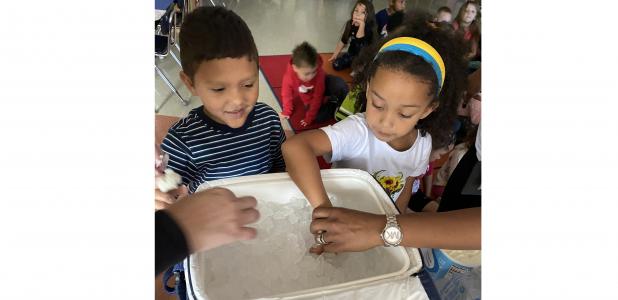Pre-K students learn about survival of arctic animals
By WENDY SLEDD
Special to Leader-Press
Whales, seals, sea lions, walruses, penguins, seabird chicks, and nearly half of aquatic and semi-aquatic animals stay warm with blubber. As Mae Stevens Early Learning Academy pre-kindergarten students shivered in recent icy conditions in Central Texas, they learned how blubber keeps animals who live in arctic conditions warm.
Teachers and paraprofessionals engaged the young scholars in a science experiment using crushed ice and cooking shortening as a representation of blubber that helps polar animals survive in the arctic climate. Students felt the coldness of the ice and then covered their hands in shortening before plunging them back into the ice and holding them there for a few seconds.
“The children observed how the shortening acts as insulation, keeping their hands warm as they handled the materials,” teacher Mandy Hunt said. “This helps their understanding of how blubber helps polar animals survive in the cold arctic climate by insulating their bodies and keeping them warm. This hands-on experiment makes the lesson more engaging and memorable for the children.”
Four-year-old Ja’kobe Finley had his hand slathered in blubber before forcing it down into the ice.
“It feels like a warm blanket,” the youngster said.
Teacher Pamela Collier said the experiment is relevant to the children’s interest and understanding of artic animals.
“It is an interesting way for them to learn about how artic animals survive in the cold,” Collier said. “Seeing the students actively participating and showing interest in the experiment demonstrates that students are engaged and invested in learning about the topic.”
Paraprofessional Brittany Hernandez said some students found it challenging to understand the concept of blubber and how it helps artic animals stay warm.
“Students enjoyed the hands-on aspect of the experiment which helped them make connections between the concept of blubber and its role in helping artic animals survive in a cold environment. This helps them to understand the importance of blubber in the survival of these animals.” Hernandez said. “Being able to touch and handle the materials made it more interesting and engaging for them.”
Paraprofessional Shannon Denson said the experiment is designed to be appropriate for pre-K children, with simple materials and instructions that they can easily follow and understand.
“The experiment allows children to use multiple senses to learn about blubber, such as touch, observation, and comparison,” Denson said. “Some students’ observations and questions during the experiment showed they had a deeper understanding of the concept than expected. They asked questions that led to further discussions including why humans do not have blubber and how our coats work like blubber to keep us warm.”
Four-year-old Nadiya Heartman understood the concept and was able to apply it to real world situations.
“My dog has a lot of blubber and that is why he is not cold,” Heartman said.

